Learn how to make einkorn sourdough bread with this simple, no-knead recipe.
Only four ingredients - all-purpose einkorn flour, salt, water and a sourdough starter are all you need for healthy, naturally-leavened bread.
With this recipe you can mix the dough and bake the bread on the same day!
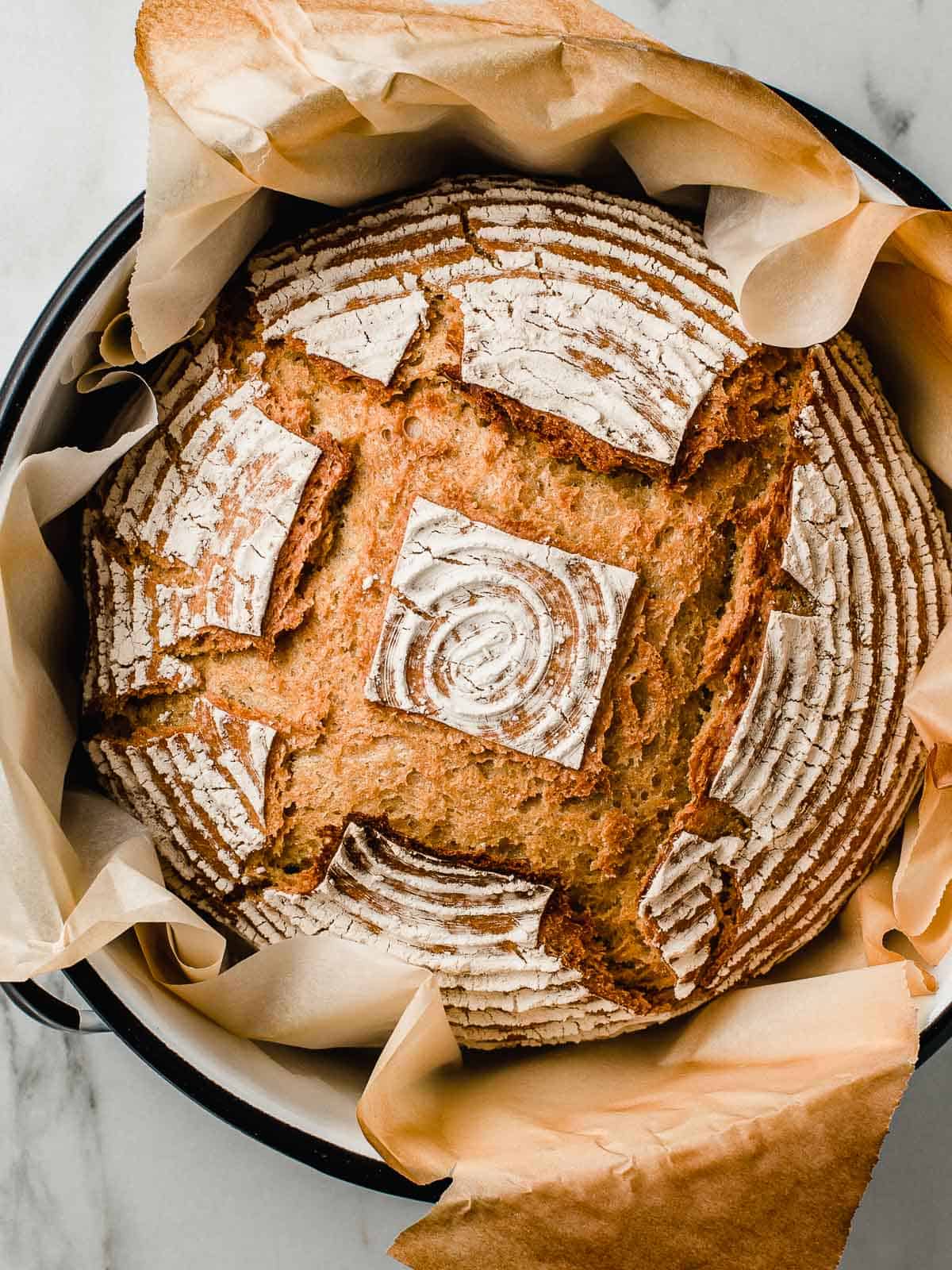
If you've never baked with einkorn flour, you are in for a real treat. This fail-proof recipe for einkorn sourdough bread will have you jumping for joy in your kitchen!
Follow the steps in this recipe and you'll get a light loaf with plenty of oven-spring.
It produces a nice, even crumb that is perfect for making sandwiches, french toast or dipping in your favorite soup!
Einkorn wheat has become our favorite way to enjoy sourdough!
Jump to:
What is einkorn?
Einkorn is the oldest form of wheat and is often referred to as an ancient grain. It is the only wheat that has never been hybridized.
Einkorn is organically grown and free from glyphosate and bleach.
Because it lacks the y-gliadins gluten protein group, which are present in all other types of wheat, einkorn flour is easier to digest then modern wheat varieties.
Einkorn also beats out modern wheat by containing more nutrients such as carotenoids, B vitamins, and essential and trace minerals.
The result is a bread that is rich in flavor, color and nutrition.
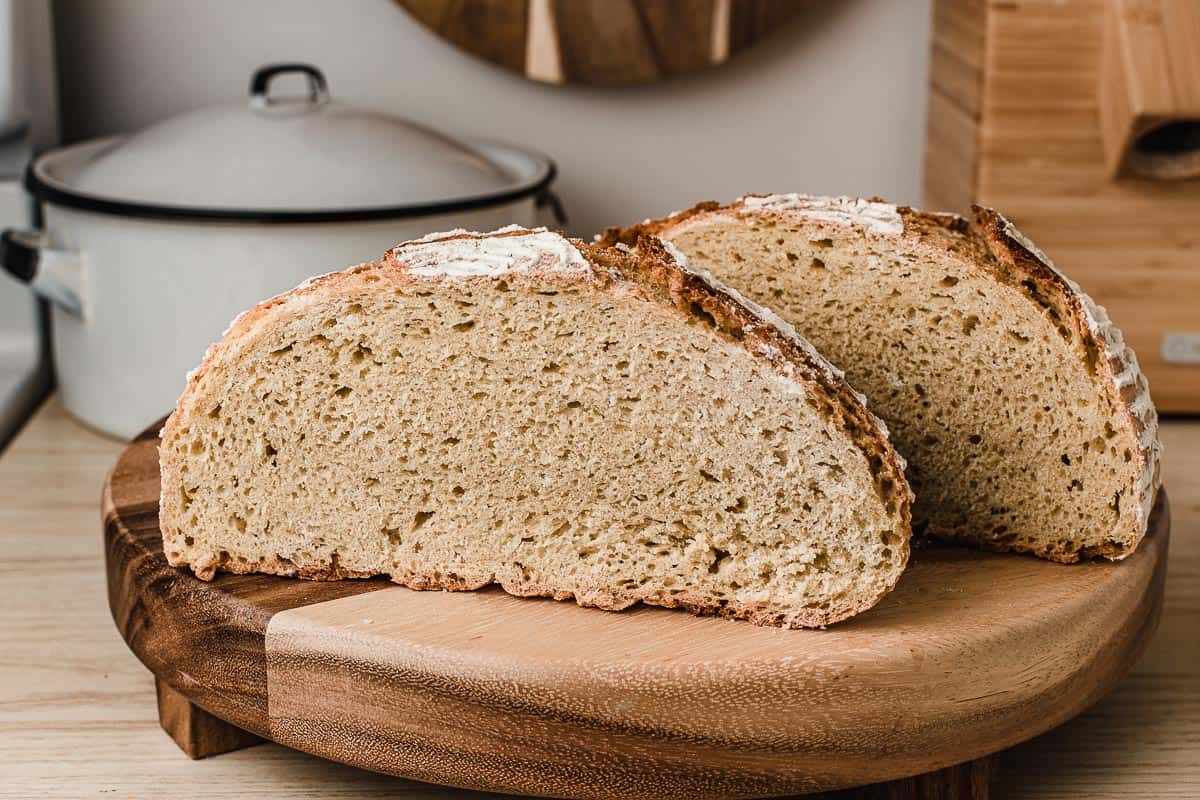
What you'll need
Just like our other sourdough bread recipes, the ingredients are simple.
- sourdough starter
- all-purpose einkorn flour (affiliate link)
- salt
- water
Equipment needed
(Amazon affiliate links) - Check out my favorite kitchen essentials.
Step by step instructions
When einkorn flour is mixed with water it is much more sticky than modern wheat. Don't be afraid to add flour as needed when folding and shaping the dough.
A bench scraper will be your most useful tool while making this bread. Be sure to have one handy!
Step one: feed the sourdough starter
The night before you wish to mix your dough, prepare your sourdough starter. Because we want a slow, overnight rise on the starter, we use a ratio of 1 part starter to 4 parts flour and water.
To a clean jar add 25g sourdough starter, 100g water and 100g all-purpose einkorn flour. Stir, lightly cover and let rise at room temperature overnight.
NOTE: If you already have a sourdough starter made with a different variety of wheat, it can be used to make this recipe.
Step two: mix the dough
To a large mixing bowl add 200g of the active sourdough starter, 300g of water, 10g of sea salt and 540g of all-purpose einkorn flour.
Use a stiff spatula or a dough whisk to mix the ingredients together.
The dough will appear dry and "shaggy".
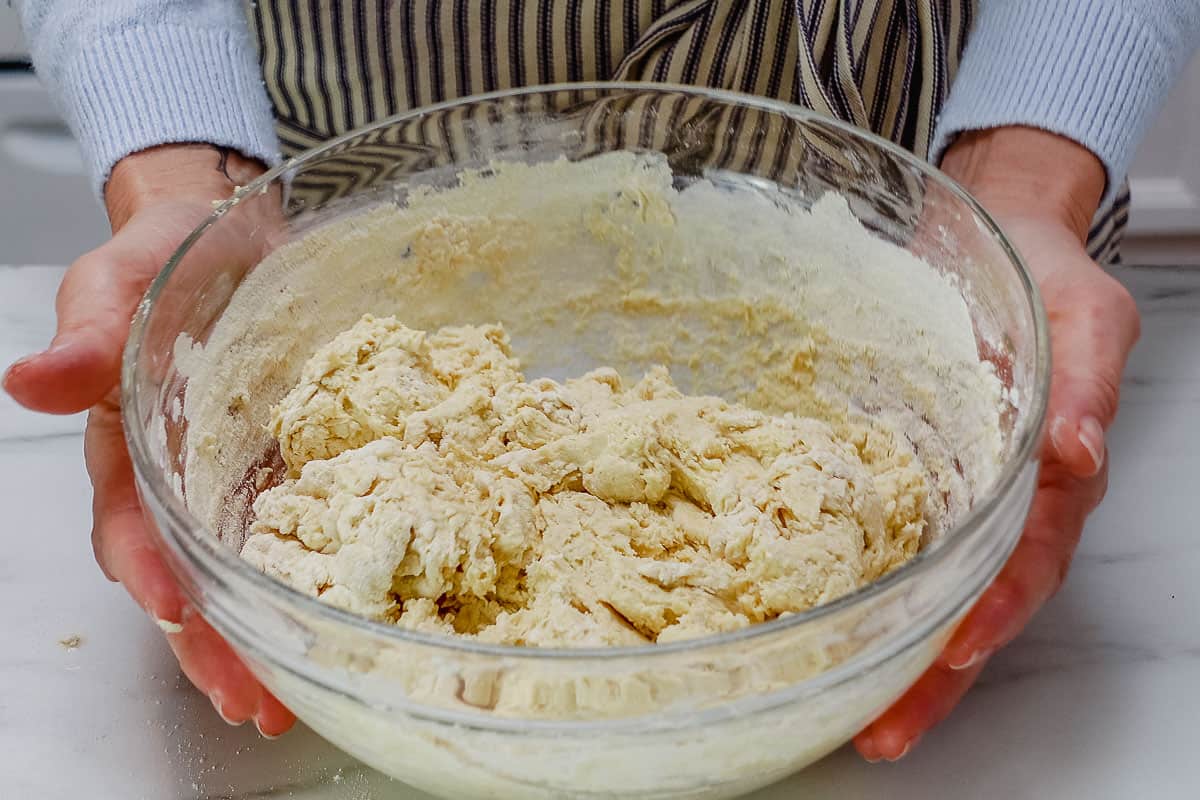
Cover the bowl and let the dough rest for 1 hour on the counter.
Step three: fold the dough
Use a bowl scraper to turn the dough out onto a floured work surface.
Flour the top of the dough and use your fingers to gently press it out into a rectangular shape.
Starting with one side of the dough, lift it up and fold it toward the center of the dough.

If the dough is sticking to the work surface, use the bench scraper to help it release.
Repeat this on all four sides of the dough and place the dough back into the bowl.
Cover the bowl and let the dough rest for 15 minutes.
Repeat the folding process one more time.
Step four: bulk rise
Cover the dough and let it rest at room temperature for 3-4 hours, or until it has risen by about 20-30%.
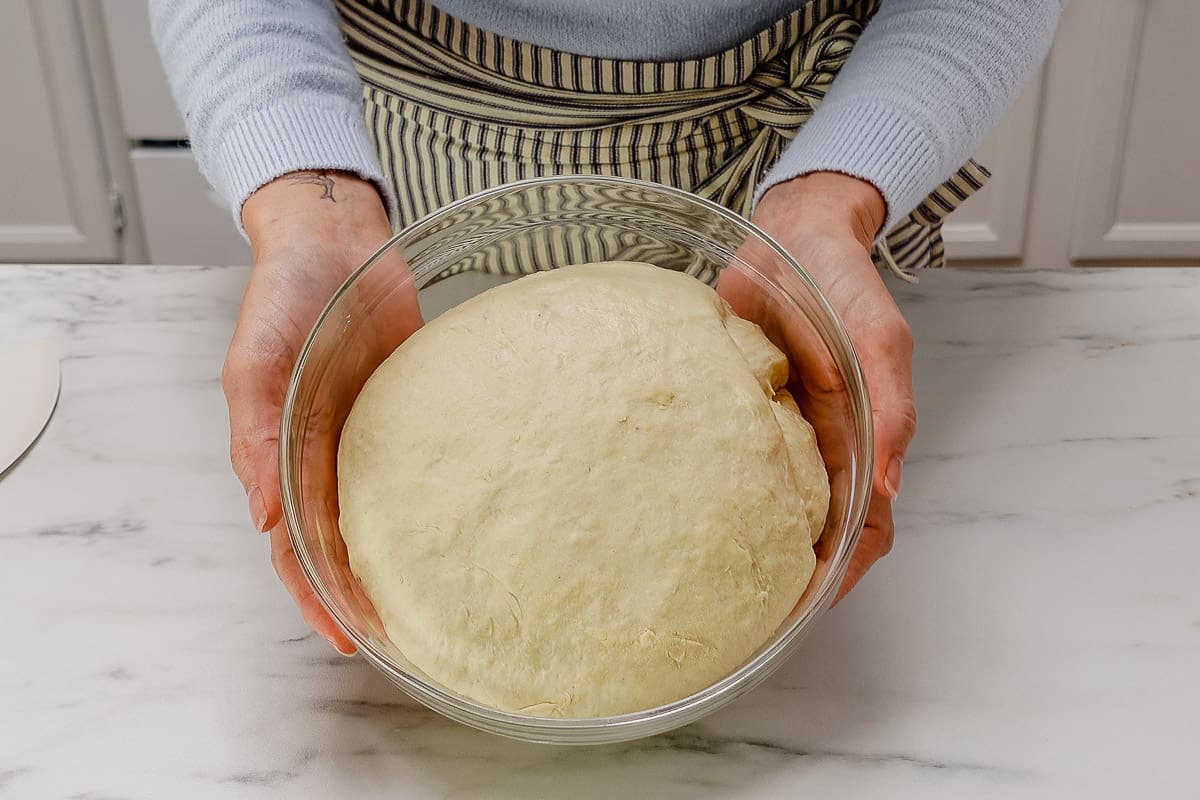
Step five: shape the dough
Generously flour a banneton or line it with a clean tea towel.
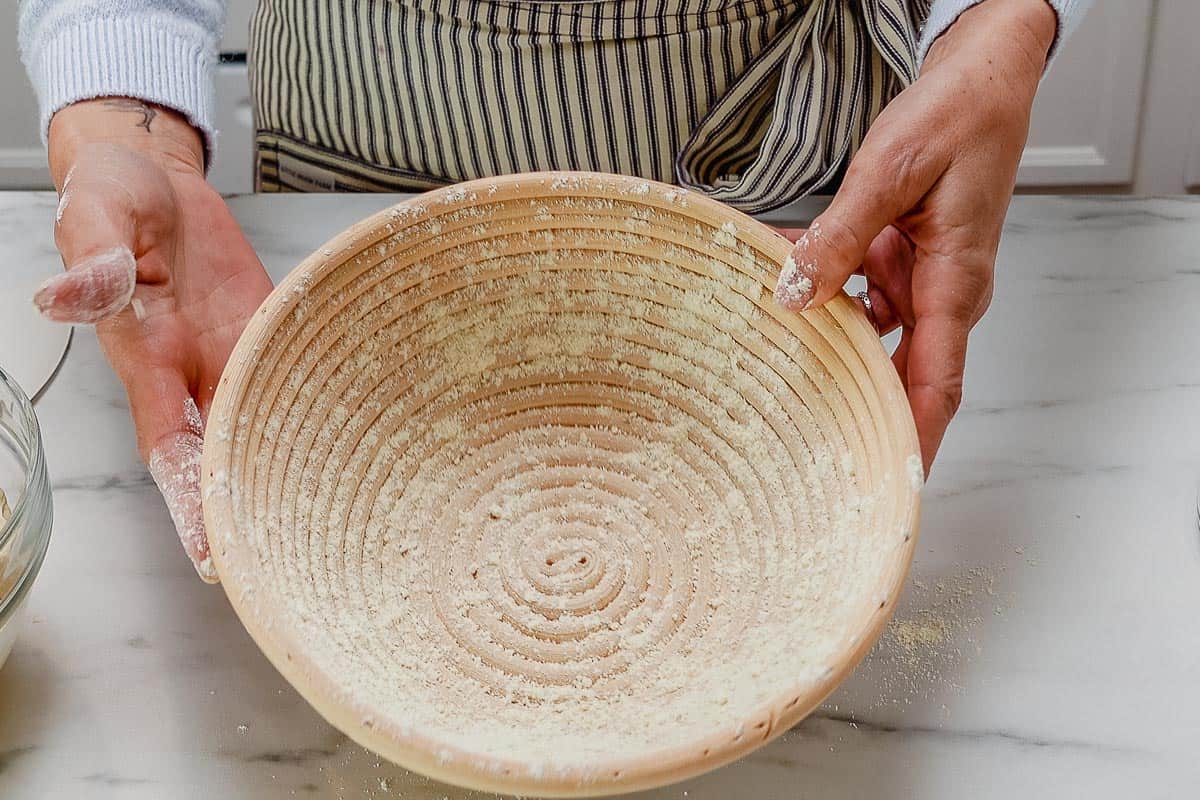
Turn the dough out onto a floured surface, but this time do not flour the top of the dough.
Pull the sides of the dough into the center.

Use the bench scraper to lift and flip the dough so that the seam-side is facing down.
Use your hands to cup the dough while gently turning it in a circular motion on the work surface.
If your hands start to stick to the dough you may lightly flour them but try not to use too much.
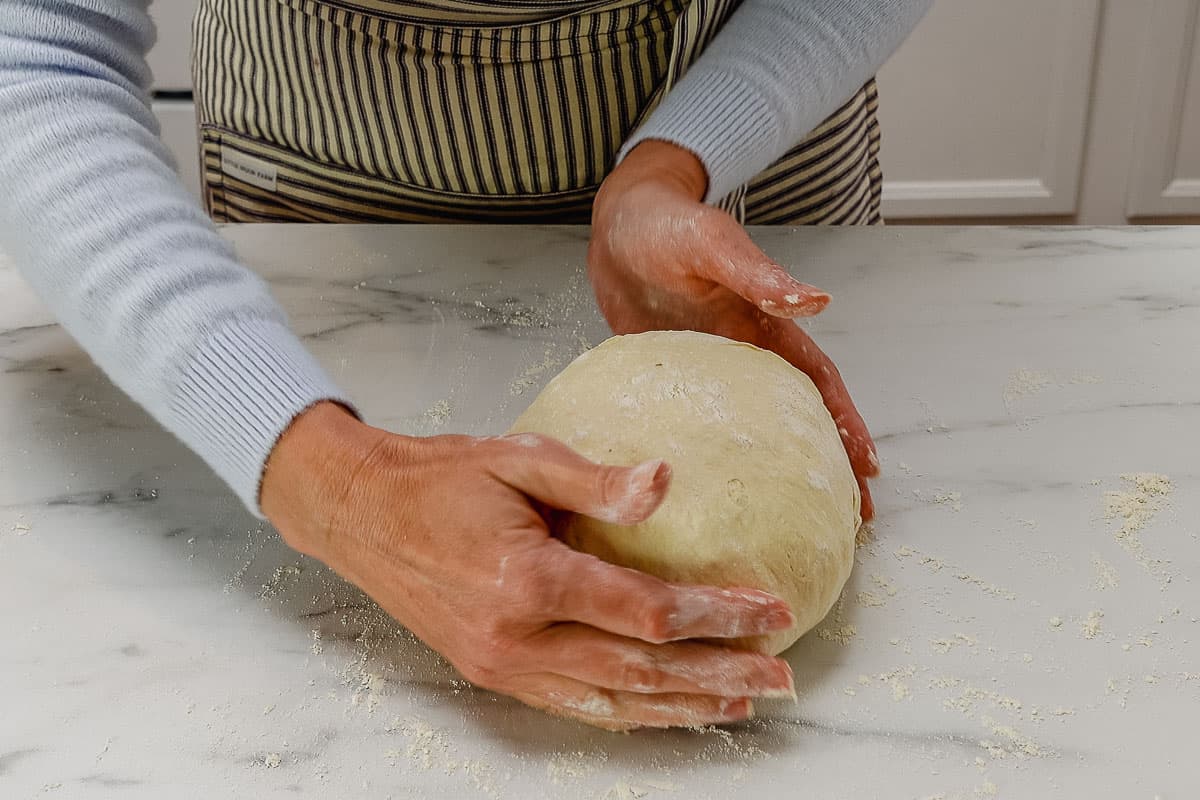
Use the bench scraper to pick up the dough and turn it over, into the banneton, with the seam-side facing up.

Cover the bowl and set a timer for 30 minutes. (This is when you'll preheat your oven.)
Allow the dough to rest at room temperature during the second rise.
Step six: second rise and preheat oven
The second rise will take about 90 minutes from start to finish, with the oven preheating in the final hour.
After the dough has rested for 30 minutes in the banneton, place your dutch oven into the oven on the second to lowest rack.
Allow the oven to preheat at 500°F(260°C) for 1 hour.
NOTE: The dough will have risen about 1 to 2 inches in the banneton when it is ready to bake.
Step seven: bake
Turn the dough out onto a piece of parchment paper and use a lame or sharp razor to score the top of the dough.
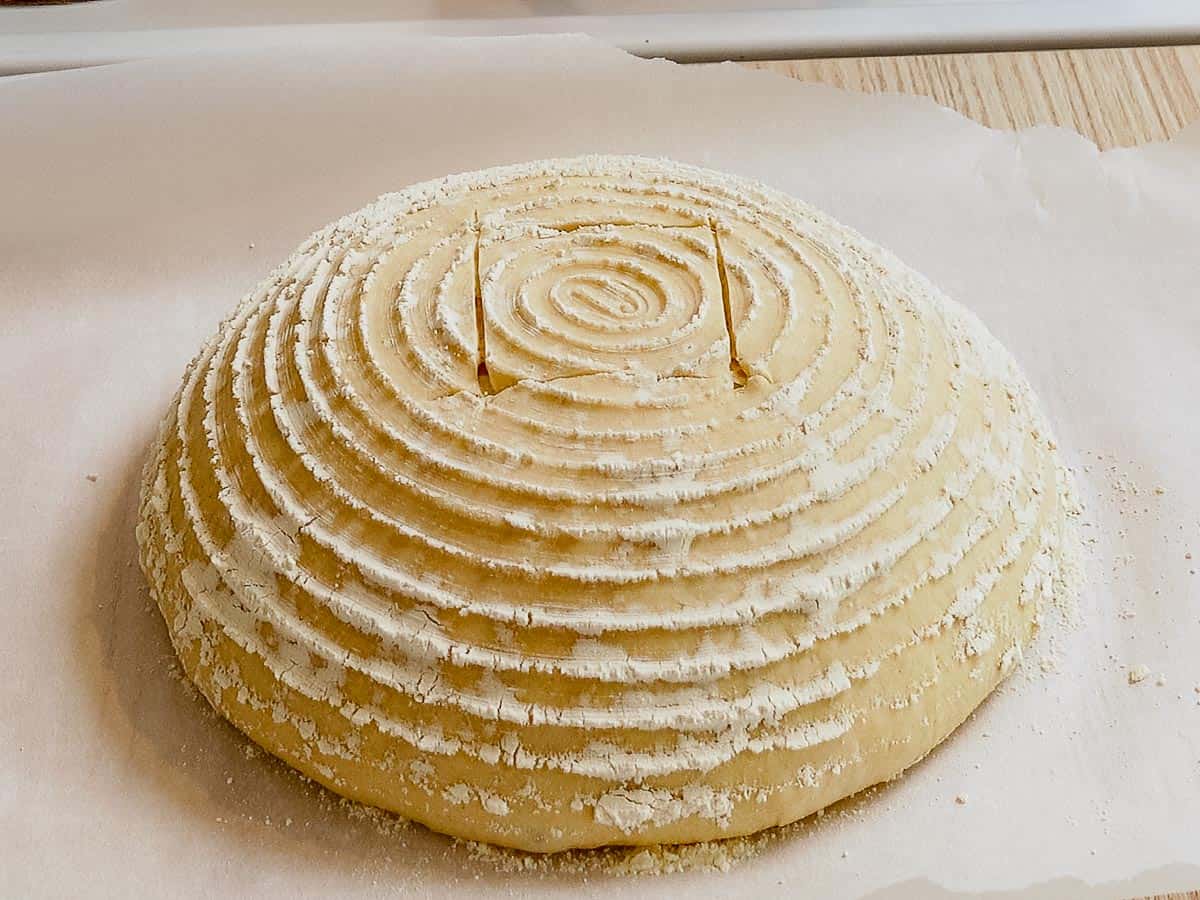
TIP: Because of the weak gluten structure of einkorn, it's important to make a shallow cut to the top of the dough, never on the sides. Do not score deeper than ¼" into the dough.
Use the parchment paper as a sling to pick the dough up and transfer it to the dutch oven. Place the lid on the pot.
Turn the oven temperature down to 450°F (232°C).
Bake the bread for 40 minutes.
After the 40 minutes is up, remove the lid and check to see if the crust is dark enough for your preference.
The bread can be baked uncovered for 5-10 more minutes in order to achieve a darker crust.
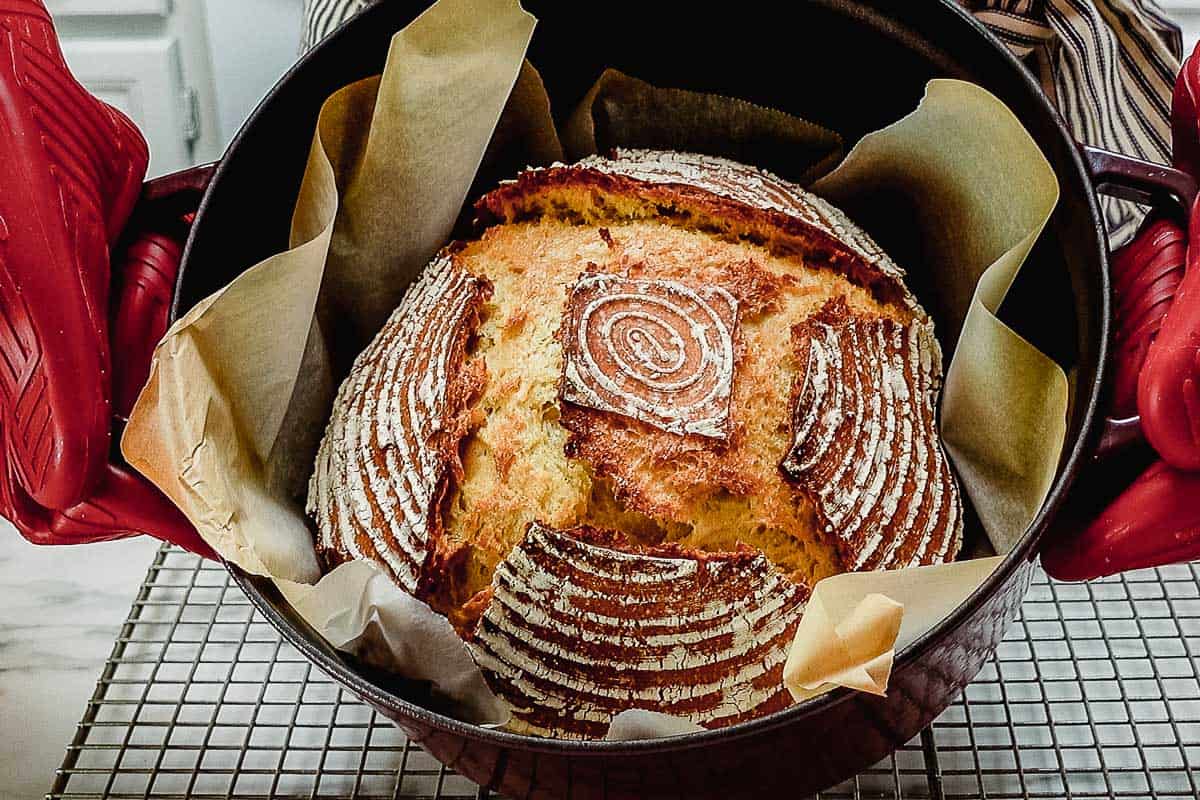
Step eight: cool
Transfer the loaf to a cooling rack and allow it to rest for 2 hours before slicing.
If you slice the bread while it is still hot, the texture of the crumb will be "gummy or sticky" from the heat and moisture.
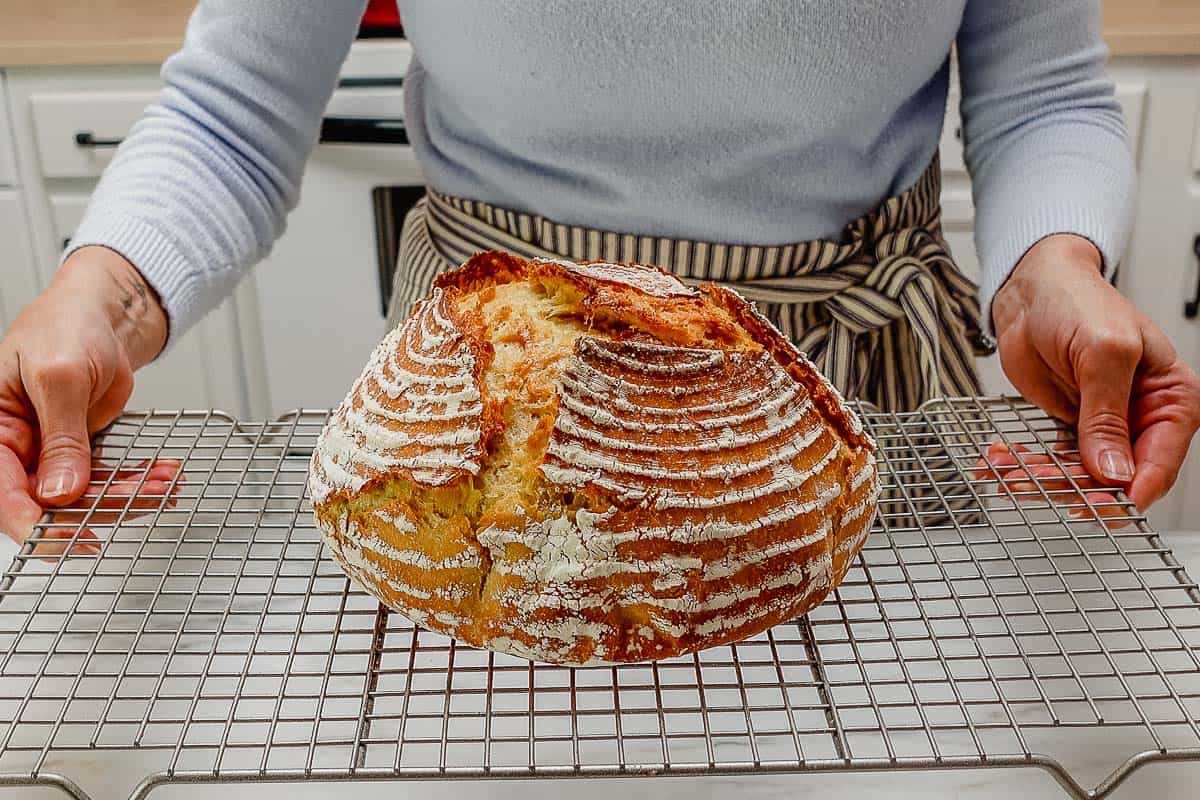
Sample baking schedule
The night before
7 PM Feed your sourdough starter so that it is bubbly and active in the morning.
The next morning
7 AM Mix the dough ingredients and let rest for one hour.
8 AM Fold the dough, cover and let rest 15 minutes.
8:15 AM Fold the dough, cover and let rest 3 hours.
11:30 AM Shape the dough and place in a floured banneton. Set a timer for 30 minutes to preheat the oven.
12 PM Place dutch oven into the oven and preheat it to 500°F (260°C) for 1 hour.
1 PM Turn the dough onto a piece of parchment paper and score the top. Transfer to the dutch oven, cover and bake for 40 minutes. Let cool for 2 hours.
NOTE: This is the schedule I use to bake einkorn sourdough bread. The temperature of my kitchen is 68°F (20°C). Warmer kitchens will require less time and cooler kitchens will require more time. Adjust your schedule accordingly.
How to store it
Store the bread at room temperature for up to 2 days either wrapped in a beeswax wrap, in a bread box, a bread bag or cut-side down on a cutting board covered with a cake-stand cover.
For long-term storage, cut the bread into slices and keep them frozen in a freezer-safe container for up to 1 month.
We love to use stasher-bags (affiliate link) for freezing sourdough bread slices.

Common questions
Einkorn is a wheat flour making it good for sourdough bread baking. A sourdough starter can be created and maintained using einkorn flour.
There are two ways to make a sourdough starter with einkorn. You can start from scratch with our sourdough starter recipe using einkorn flour OR you can convert the sourdough starter that you already have.
To convert your existing sourdough starter into an einkorn sourdough starter, take 25g of your existing starter and transfer it to a clean jar. Add 100g of einkorn flour and 100g of water, stir and let rise at room temperature. After about 4 feedings, your starter should be completely converted to einkorn.
Einkorn wheat contains the protein gluten and is NOT safe for anyone with celiac disease to eat. Einkorn sourdough is not gluten free.
More easy sourdough recipes
Do you like this recipe? Make sure to subscribe to our newsletter and we'll send you the latest and greatest!
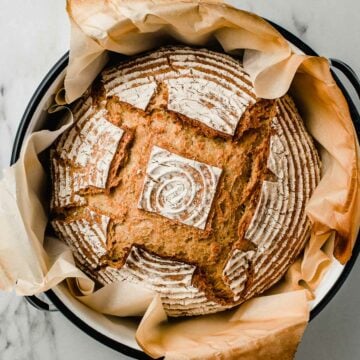
Einkorn Sourdough Bread
INGREDIENTS
INGREDIENTS TO MAKE 1 CUP (200 G) OF ACTIVE SOURDOUGH STARTER
- 1 ½ tablespoons (25 g) sourdough starter
- ¾ cup + 1 tablespoon (100 g) all-purpose einkorn flour
- 7 tablespoons (100 g) water
Dough Ingredients
- 1 cup (200 g) active sourdough starter
- 1 ¼ cup (300 g) water
- 4 ⅕ cups (540 g) all-purpose einkorn flour
- 2 teaspoons (10 g) sea salt
INSTRUCTIONS
Feed your sourdough starter
- 12 hours before you plan to mix the dough, add the ingredients to make 1 cup (200 g) of active sourdough starter to a clean jar: 25g sourdough starter, 100g einkorn all-purpose flour and 100g water. Stir until combined, loosely cover the jar and let the starter rise at room temperature. (The ingredients will create a total of 225 g active starter but, because some of it will stick to the sides of the jar during the transfer, we are making a little more than needed.) The sourdough starter is ready to use when it has doubled in size and there are plenty of bubbles on the surface and sides of the jar.
Make the dough
- Mix the dough ingredients. Add the 200g active sourdough starter, 540g all-purpose einkorn flour, 300g water and 10g salt to a large mixing bowl. Use a dough whisk or an off-set spatula to mix the ingredients together until there are no dry bits left in the bowl. Cover the bowl and let the dough rest for 1 hour.
- Fold the dough. Use a bowl scraper to turn the dough out onto a floured work surface. Flour the top of the dough and use your fingers to gently press it out into a rectangular shape.Starting with one side of the dough, lift it up and fold it toward the center of the dough. If the dough is sticking to the work surface, use the bench scraper to help it release. Repeat this on all four sides of the dough and place the dough back into the bowl. Cover the bowl and let the dough rest for 15 minutes. Repeat the folding process one more time.
- First rise. Place the dough back into the bowl and cover. Allow the dough to rise at room temperature for 3-4 hours or until it has risen by 20-30%.
- Shape the dough. Turn the dough out onto a floured surface. Pull the sides of the dough into the middle, working all the way around the outside and then flip the dough over. Use your hands to cup the dough around the bottom near the work surface and turn it so that the dough forms a taut ball.
- Second rise. Place the dough, seam-side up in to a floured banneton or one lined with a clean tea towel. Cover the dough and allow to rise at room temperature. Set a timer for 30 minutes.When the timer goes off, turn on the oven to preheat to 500°F (260 °C) with the dutch oven inside. Set a timer for 1 hour and allow the oven to preheat for the final hour of the second rise. (The dough will rise for a total of 1 hour and 30 minutes.)
- Score the dough. Remove the dutch oven and set on top of your stove. Turn the dough out onto a piece of parchment paper. Score the top of the dough with a razor or sharp knife no deeper than ¼". Use the parchment paper like a sling to transfer the dough to the dutch oven. Cover with the lid and place it back into the oven. Turn the oven down to 450°F (232 °C)
- Bake for 40 minutes with the lid on. Remove the lid and check to see if the crust is dark enough to your liking. If it is, remove it and let cool. If not, bake for an additional 5-10 minutes uncovered.
- Cool. Allow the bread to cool for 2 hours before slicing.
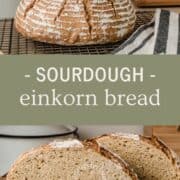

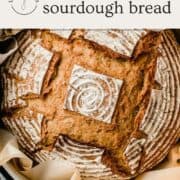
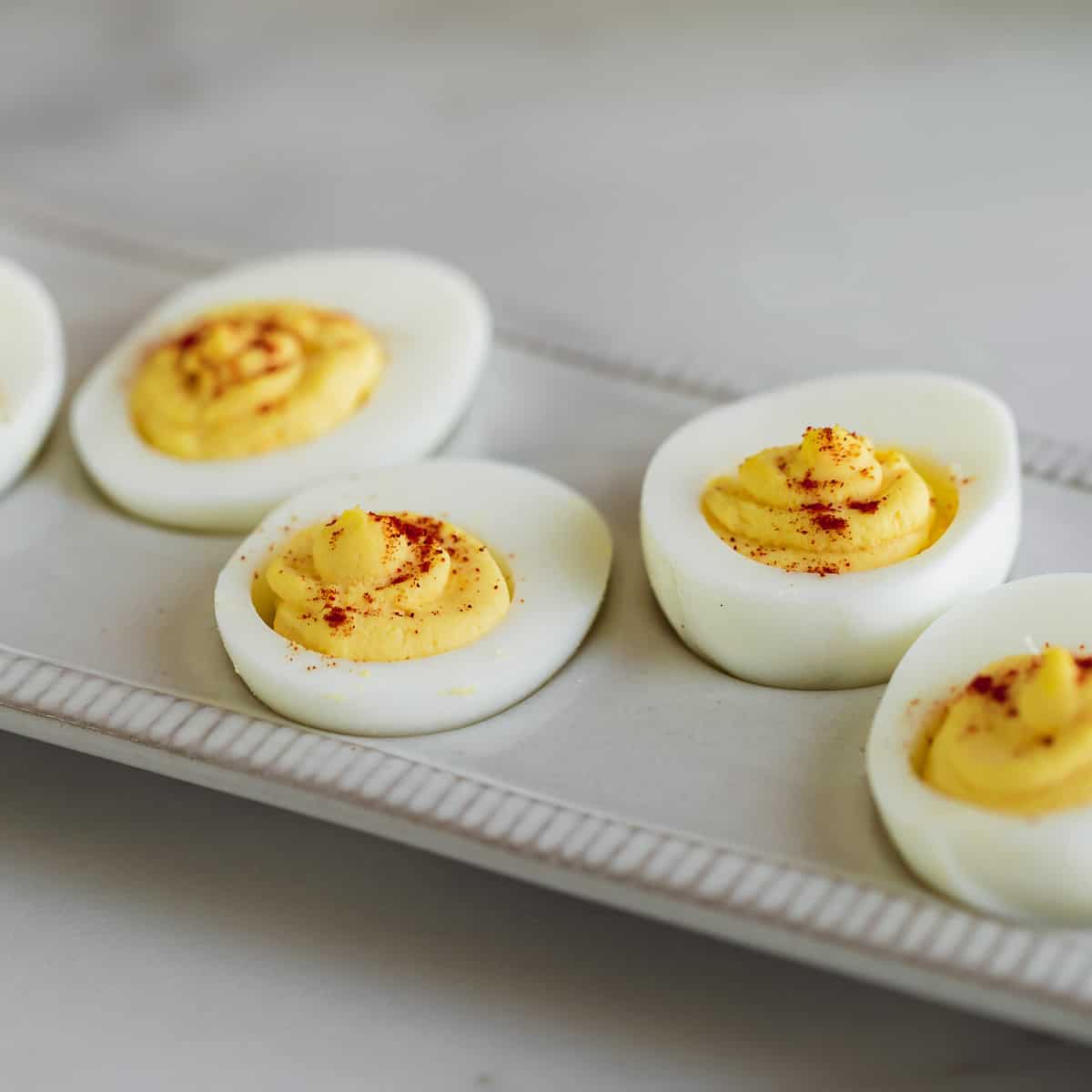
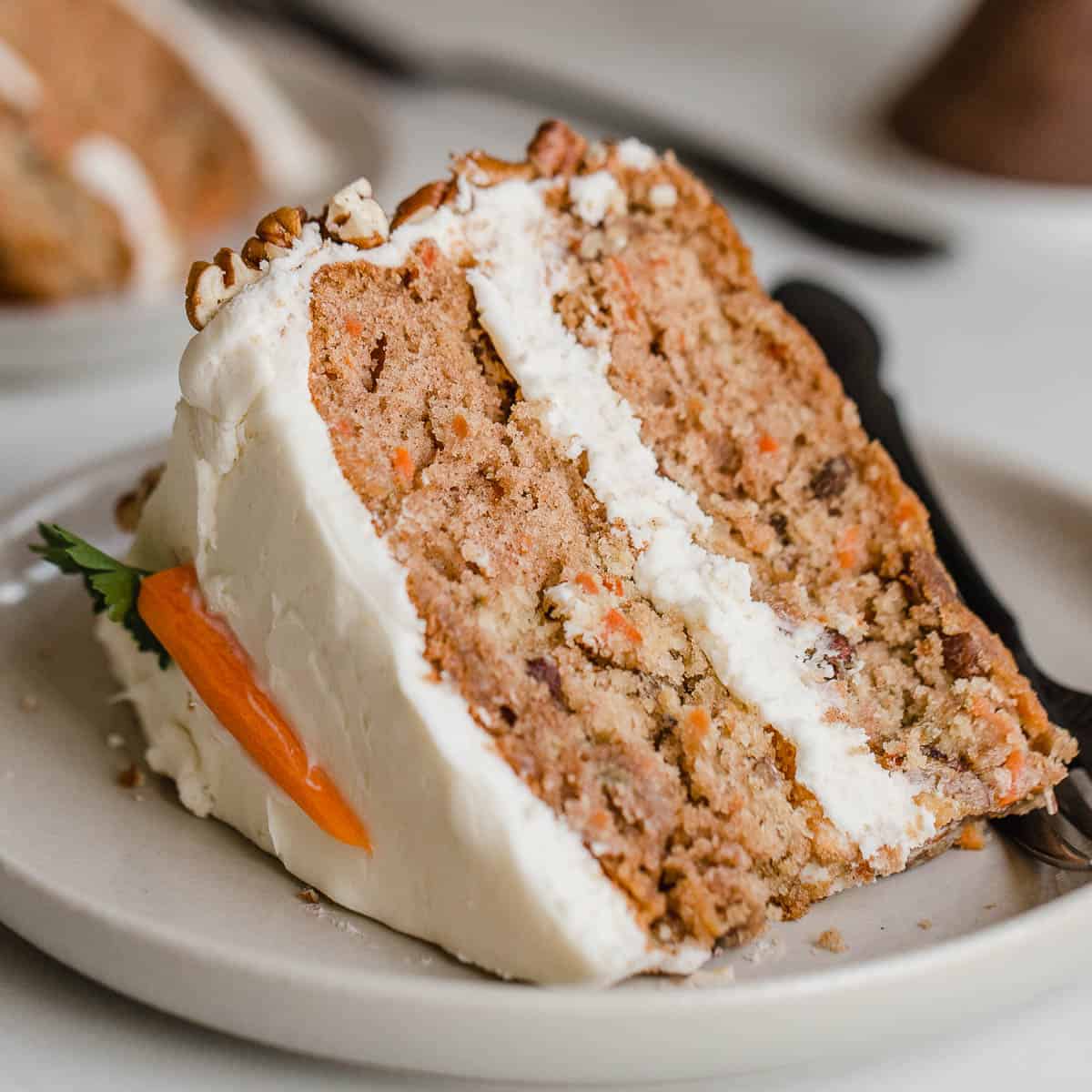
Jen says
My family loves this bread. We have been baking it for months now. Since it has gotten warmer, my loaf isn't rising like it used to. Any advice on how to get it to rise?
Amy says
Hi Jen, do you mean when it is baking or during the fermentation process?
Jen says
It rises during the fermenting process but not when baking. I don't know if I should let it ferment shorter since it's hotter now?
Amy says
Yes, shorten the fermentation time and see if that helps!
Julia says
This is hands-down the simplest and best sourdough recipe I have ever made! Bread was super delicious. I used a blend of AP, whole wheat einkorn and rye and it came out perfectly.
Amy says
Thank you so much Julia! 🙂
Debra says
Thanks so much for this great recipe! It’s my first, one and only recipe for einkorn. I pause after shaping and put dough in refrigerator until morning to bake. It’s delicious!,,
Lee Bruton says
Made this bread, wow, amazing bread, now going to be my number 1 bread!! Really enjoyed making this bread.
Thank you!! Now to look at your other recipes!!
Jane Albright says
Simple recipe and easy to make even for a novice like me. I love einkorn flour, and this makes a wonderful, tastey, sour-y loaf. I like that I can make one loaf at a time. I love it!
Casey says
Terrific recipe for einkorn beginners, thank you! The timing is good to pay attention to but still go according to what you see, too. My kitchen is a little warmer so the rising happened a little faster. I think it overproofed a bit - but was still good!
Is there any point in this process where you could pause, put the dough in the fridge, and resume in the morning? For someone who may have timed it poorly? Asking for, um, a friend.
Amy says
HI Casey! You can put the dough in the fridge after you have shaped it. It will continue to slowly rise in the fridge and should be ready to go in the morning. 🙂
Mame Noonan says
I used your recipe for making starter back in April 2020 and have maintained it since. I often make the sourdough country loaf and recently learned about Einkorn flour. This my new go-to loaf. I was also inspired to start using my banneton!
Carol Raulston says
This was by far the most challenging sourdough I've baked, still a newbie @ 6 months, but the most beautiful! I followed your instructions exactly except I added an extra fold. The rise is incredible and the way you said to score is beautiful! Do you have an IG or FB account? I would love to tag you!
Zahida F says
First %100 einkorn loaf, and I'm more than happy with this recipe. The instructions are very clear and precise and the results were AMAZING!
E. says
What did you use for a starter then? Everything i find even this blog is using a whole wheat/modern flour starter including this one.
Tom Purdy says
Following your recipe and video, I just produced a perfect loaf my very first time! I used a convection oven preheated to 475F and baked 40 minutes at 425F. My son and daughter-in-law loved it -- "it's just like the loaves they used to buy at the farmers market in SFO". My only surprise was that dough was far more sticky than anything I've ever used before -- it was like getting gorilla glue out of the mixing bowl! But ultimately, the results were well worth the effort. Thank you for sharing this and your other recipes, together with your experience, techniques and advice!